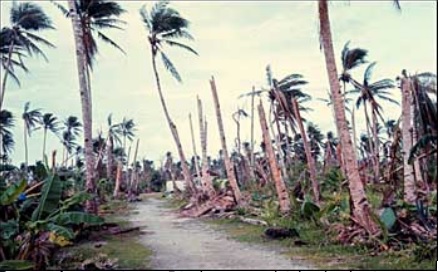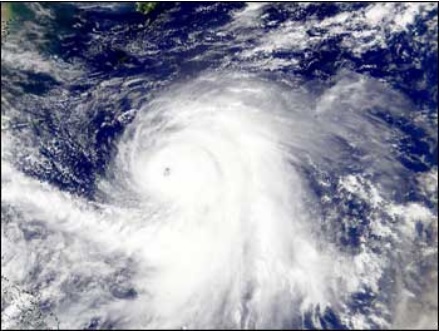When Typhoon Kai-Tak crashed into the shores of Taiwan, Japan, and the Philippines in July 2000, it left up to a million people homeless and 40 dead in the Philippines, according to a BBC report. In Japan three people died, and in Mito, a town northeast of Tokyo, landslides crushed dozens of homes. Japanese disaster officials estimated damage at about $2.6 million. According to the Taipei Times, gusts caused a large-scale blackout in eastern and southern Taiwan and left nearly 10,000 families without electricity.
But just like the storm-chasers who realize they have much to learn from the Midwest's tornados, scientists hovered near the South China Sea hoping to discover whether cyclones help increase phytoplankton production and, therefore, reduce carbon-dioxide gases in the Earth's atmosphere.
Tropical cyclones are one of the most intense storms on Earth, with torrential rains and winds that sometimes exceed 175 knots (320 kilometers) per hour. The term "typhoon" is a regionally specific name that refers to a severe tropical cyclone in the western Pacific. Wind speeds must reach 64 knots (118 kilometers) per hour for a tropical cyclone to rank as a typhoon.
In the past, gathering scientific data by ship about typhoons appeared impossible for the same reasons coast dwellers fear them: high winds and tumultuous rains. In addition, the cloud cover that follows typhoons creates a foggy barrier that most satellites can't "see" through. Sensors must capture wind speeds and ocean temperatures as they're happening, because they change so quickly.
But in 2000, a team of scientists in Taiwan patiently monitored 20 typhoons in the South China Sea, hoping for a convergence of circumstances that could aid them in their research: satellites in the right places at the right times and a slow-moving storm. After Kai-Tak subsided, the researchers discovered serendipity in its wake.
"In fact, we discovered this event by accident," said I-I Lin, research scientist at Taiwan's National Center for Ocean Research in Taipei. "During our routine processing of high-resolution Sea-viewing Wide Field of View Sensor (SeaWiFS) images, we observed an unusually high level of chlorophyll-a concentration during Kai-Tak. This prompted us to start a series of studies on the subject."
Phytoplankton are tiny, floating algae, or plantlike organisms, that produce half the world's oxygen and provide a major food source for marine life. They are almost invisible, but after the typhoon, NASA's SeaWiFS ocean color sensor detected the phytoplankton's pigment, known as chlorophyll-a.
The team then discovered that the phytoplankton bloom occurred in the same area where TRMM (Tropical Rainfall Measuring Mission) data showed a 16-degree (Fahrenheit) temperature drop after the storm. Quick Scatterometer (QuikSCAT), a NASA-operated satellite that measures wind speeds over water, determined Typhoon Kai-Tak's wind speeds and path, which revealed that Kai-Tak had lingered in exactly the same spot where the lower temperature and phytoplankton bloom occurred. SeaWiFS and TRMM data are archived at the Goddard Earth Sciences Data and Information Services Center (GES DISC), and QuikSCAT data are available from NASA's Physical Oceanography Distributed Active Archive Center (PO.DAAC).
The images caught by the three satellite instruments showed that Kai-Tak's winds pulled nutrient-rich water from deep below the South China Sea's surface, thus exposing those nutrients to sunlight. Phytoplankton bloomed and, by using carbon dioxide for photosynthesis, removed harmful greenhouse gases from the Earth's atmosphere.
"Scientists had known for some time that something was eating up carbon dioxide in that region, but they hadn't been able to prove any theories," said Timothy Liu, principal investigator for NASA's QuikSCAT and TRMM projects at NASA's Jet Propulsion Laboratory (JPL) in Pasadena, California.
The scientists estimated that Kai-Tak accounted for 2 to 4 percent of the total new production of phytoplankton in the South China Sea that year. Liu said an average of 14 typhoons storm through the South China Sea each year and could contribute as much as 20 to 30 percent of new phytoplankton growth. The idea wasn't new--it just hadn't been proven before Typhoon Kai-Tak. "Lo and behold, we caught this high-tech synergism of many satellite observations at the right moment," Liu said. "It is difficult to find observations by three sensors at the same spot in appropriate time sequence. That is why such direct cause (wind forcing) and effect (temperature and biological response) have not been demonstrated before. Without the data from all three instruments, we could not have done it."
Both Liu and Lin grew up understanding the harmful effects of cyclones. Liu spent his childhood in Hong Kong before moving to the United States as a teenager, and he remembers typhoons as "exciting and scary." "In Hong Kong, there were a lot of typhoons, and I was always fascinated by them," he said.
Lin, who served as a team member in Taiwan's "Integrated Typhoon Research Project," also has lived under the constant threat of the storms. "In Taiwan, typhoon research is a top priority because each year, cyclones cause damage to many Asian countries," she said.
Typhoon Kai-Tak hovered from July 5 to July 8 over the same 150-kilometer (93-mile) area in the South China Sea, generating winds from 20 to 40 meters per second (44.8 to 89.6 mph). "It's rare for a cyclone to stay in the same place for one or two days," Liu said. "The South China Sea happens to be a closed sea, so there is little outside influence (from ocean currents) on the thermal and biological responses."
Because Kai-Tak lingered, the researchers had more time to look at the ocean water movement than they would have if the typhoon had rushed past. And because the South China Sea is closed, they knew all the water movement was caused directly by Kai-Tak.
Normally, currents in the South China Sea cause the water to remain in static layers, so water on top always stays on top, and water deep below the surface always stays below the surface. This is because in a subtropical ocean, the normal large-scale surface circulation is clockwise, Liu explained.
But Kai-Tak, like all Northern Hemisphere cyclones, moved counterclockwise (Southern Hemisphere cyclones move clockwise). This created a hollow in the sea, similar to the funnel that forms above a drain when water leaves a bathtub. But in the sea there is, of course, no drain, so water from below the hollow moved up to fill the empty spot.
"The wind and current in a typhoon are anti-clockwise (cyclonic), causing surface water to diverge," Liu said. "When surface water diverges, it has to be replaced by water from the deep. Although the area covered by a typhoon is very small compared with the whole ocean basin, and a typhoon lasts only a short time, we suggested that the cumulative effect of many typhoons might be sufficient to offset the basin-wide circulation patterns."
So, as Kai-Tak, a category 2 typhoon on the Saffir-Simpson hurricane scale, floated over the sea, it forced cold water up from 70 meters below up to the top 20 to 30 meters of surface layer, which caused the cold spot detected by the TRMM sensor. The deeper the water, the more nutrient-rich it is. But since sunlight only reaches surface water, phytoplankton cannot grow deep below the surface. When the cyclone forced the deep water to the surface, sunlight hit the nutrients, which caused phytoplankton to form. SeaWiFS then captured the increase in chlorophyll-a.
"When cold water comes up, it brings nutrients with it," Liu said. "It is a dramatic event that we can see in the satellite imagery. The cool water is a strong blue color, and the biological bloom is visible in the same spot."
Before Kai-Tak, SeaWiFS measurements showed chlorophyll-a measurements at levels typical for summertime tropical waters. But after the cyclone, chlorophyll-a measurements increased 30 times, Liu said. "We knew the cyclone would bring up nutrients from below, but no one had really seen this before," Liu said. "The satellite data now enable us to detect things we could not see through the clouds--it's really revolutionary."
Scientists had long suspected that strong winds cause entrainment, or vertical mixing, in tropical and subtropical oceans, explained Lin and colleagues in a paper published in the October 2003 issue of Geophysical Research Letters. But it took measurements from the three satellite sensors to prove it.
"This research is important because it confirms that the impact of cyclones on ocean primary production is significant, at least in the South China Sea," Lin said. "It also points to the potential impact tropical cyclones have on climate change, since primary production is critical to global climate."
The new technology has also illuminated future research options for the scientists. "We've now established a method to quantify the cyclone-induced phytoplankton growth using a combination of remote-sensing data and models," Lin said. "This method can be applied to other typhoon cases and in different oceanic regions, too. Previously, it was impossible to do such work due to the lack of observations by traditional means."
The researchers are encouraged to find good news in such a disastrous force--especially when it had been so difficult to prove their theory in the past. "Cyclones have a potent effect on carbon in the South China Sea," said Liu. "The catch is that for most people, they are a destructive force. But if you look at it another way, they enhance life."
References
Killer Storms in Philippines and Japan [4]. BBC News. Accessed July 26, 2004.
Typhoons leave 3 dead in Japan, 42 dead in Philippines [5]. CNN. Accessed July 26, 2004.
For more information
NASA Goddard Earth Sciences Data and Information Services Center (GES DISC)
NASA Physical Oceanography Distributed Active Archive Center (PO.DAAC)
Tropical Rainfall Measuring Mission (TRMM)
Sea-viewing Wide Field-of-view Sensor (SeaWiFS) Project
Air-Sea Interaction and Climate
| About the remote sensing data used | ||
|---|---|---|
| Satellite | Tropical Rainfall Measuring Mission (TRMM) | Sea-viewing Wide Field-of-view Sensor (SeaWiFS) |
| Parameter | cyclones and phytoplankton production | cyclones and phytoplankton production |
| DAAC | NASA Goddard Earth Sciences Data and Information Services Center (GES DISC) | NASA Physical Oceanography Distributed Active Archive Center (PO.DAAC) |


